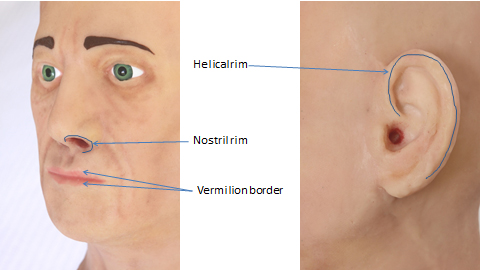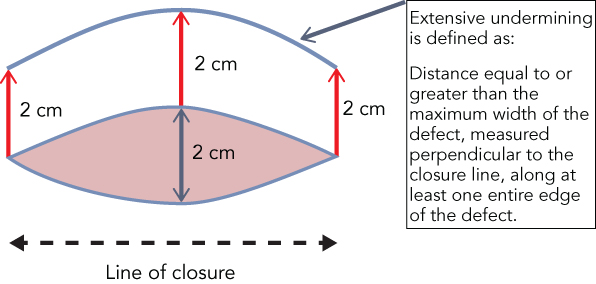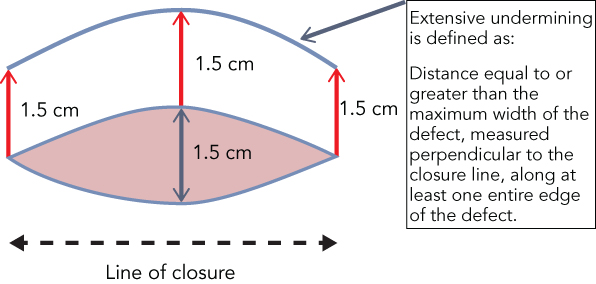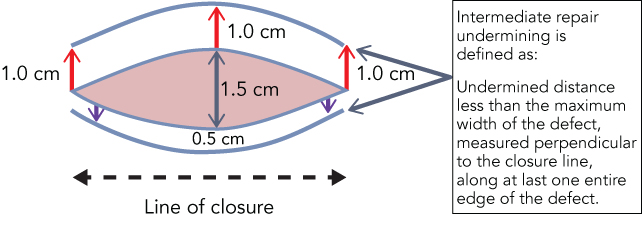Carking the code 2
INTERMEDIATE AND COMPLEX REPAIRS 2020: PART 2

Cracking the Code
Dr. Miller, who is in private practice in Yorba Linda, California, represents the American Academy of Dermatology on the AMA-CPT Advisory Committee.
By Alexander Miller, MD, November 1, 2019
Last month's Cracking the Code column presented the newly revised 2020 CPT® guidelines for intermediate and complex repairs. Below is a review of intermediate and complex repair criteria followed with illustrations of their salient features.
Intermediate repair
Includes simple repair
Requires layered closure of one or more of the deeper layers of subcutaneous tissue and superficial (non-muscle) fascia
Includes limited undermining (defined as a distance less than the maximum width of the defect, measured perpendicular to the closure line, along at least one entire edge of the defect)
May constitute: single-layer closure of heavily contaminated wounds that have required extensive cleaning or removal of particulate matter
Complex repair
Must meet requirements for intermediate repair (e.g., layered closure)
Must include at least one of the following:
Exposure of bone, cartilage, tendon, or named neurovascular structure
Debridement of wound edges (e.g., traumatic lacerations, avulsions)
Extensive undermining (defined as distance equal to or greater than the maximum width of the defect, measured perpendicular to the closure line along at least one entire edge of the defect)
Involvement of free margins of helical rim, vermilion border, or nostril rim
Placement of retention sutures

Intermediate repair: Undermining

Since the sum of undermined distances in the example above equals 1.5 cm, the maximum defect width, one may believe that this constitutes extensive undermining, thus justifying a complex repair. However, the CPT definition of limited and complex undermining does not allow for summation of distances undermined on both defect sides. Consequently, this example illustrates limited undermining and would be reported as an intermediate repair.
Complex repair: Undermining (1)

Document:
Extensive undermining done along at least one wound edge
Maximum width of defect perpendicular to line of closure
Width of undermining done or undermining was equal to or greater than the maximum width of defect
Complex repair: Undermining (2)

Document:
Extensive undermining done along at least one wound edge
Maximum width of defect perpendicular to line of closure
Width or undermining done or undermining was equal to or greater than the maximum width of defect
Example 1: You excise a tumor from the nose alar rim and repair the defect linearly with buried dermal stitches followed with a second layer of surface stitches. No undermining is done. You report a complex repair.
Answer: Correct. The layered repair involved the free margin of the nostril (alar) rim. This satisfies criteria for complex repair.
Example 2: A fusiform excision on the cheek measures maximally as 1.5 cm perpendicular to the layered repair's line of closure. Undermining is done along both entire edges of the fusiform defect, 1.0 cm on one side and 0.5 cm on the opposite side. The combined distance of undermining equals the maximum defect width, 1.5 cm. Consequently, a complex repair code is reported.
Answer: Incorrect. Although the total diameter of undermining equals the maximum width of the surgical defect, 1.5 cm, neither side was undermined to at least 1.5 cm. To meet the definition of complex repair, undermining would have to be done to at least a 1.5 cm diameter along one entire side of the surgical line of closure.
Example 3: A fusiform excision on the cheek measures 2.2 cm maximum width perpendicular to the long axis of closure. Undermining is done to 2.5 cm centrally and 2.0 cm distally along one edge of the line of closure. A complex repair is billed.
Answer: Incorrect. The definition of a complex repair specifies that undermining should be done equal to or greater than the maximum width of the defect measured perpendicular to the line of closure. In this case, undermining was done centrally to a distance greater than the maximum width, 2.2 cm, but along the distal edges undermining measured 2.0 cm, which is less than the maximum width. Consequently, this is an intermediate repair.
Example 4: You undermine both excision edges and do a layered repair. Since one entire closure edge was undermined to a distance greater than the maximum diameter of the defect measured perpendicular to the line of closure, you report a complex repair. You document the following in your patient record: Total 1.5 cm undermining from the entire medial edge of the line of closure was done and layered repair was done. The patient's insurer requests to review the medical record documentation and then reduces the charge to an intermediate repair. Why?
Answer: One cannot predict the degree of detail that health care claim reviewers may want to see in order to validate a complex repair closure. It would be wise to report both the maximum width of the defect perpendicular to the line of closure as well as the distance of undermining done along the entire lines of closure. Some payers may insist on documentation indicating number of stitches placed and mention of the deeper tissue involved.
The above example recorded the undermining distance but not the maximum width. The medical record should at least state the maximum width and whether undermining was done along an entire line of closure to a distance equal to or greater to, or less than, that width.
Additional Dermatology World Resources
Skin Care Physicians of Costa Rica
Clinica Victoria en San Pedro: 4000-1054
Momentum Escazu: 2101-9574
Please excuse the shortness of this message, as it has been sent from
a mobile device.
posted by dermatica at
November 08, 2019
![]()
![]()

0 Comments:
Post a Comment
Subscribe to Post Comments [Atom]
<< Home